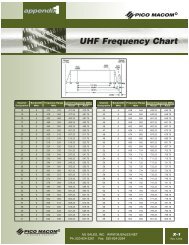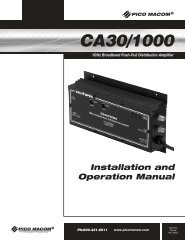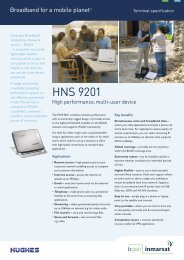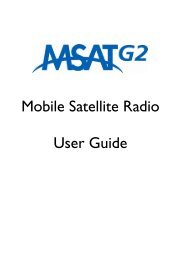IRIDIUM active antenna - Intallation Manual - GeoBorders
IRIDIUM active antenna - Intallation Manual - GeoBorders
IRIDIUM active antenna - Intallation Manual - GeoBorders
Create successful ePaper yourself
Turn your PDF publications into a flip-book with our unique Google optimized e-Paper software.
AD520-10 Active Transmitter/Receiver Antenna with 40m<br />
RG213U down-lead and DC regulator for Iridium Telephone<br />
Systems<br />
Introduction<br />
Iridium telephones were originally designed to operate with passive <strong>antenna</strong>e, either an<br />
element attached directly to the handset, or a remote aerial connected with a short length<br />
of coaxial cable. Unfortunately, a signal loss of more than 3dB in a remote <strong>antenna</strong>’s<br />
connecting cable degrades performance due to attenuation of both the received and<br />
transmitted signals. A 3dB loss corresponds to approximately 10m of RG213U or 3m of<br />
RG58U coaxial cable, lengths that clearly restrict the mounting options for the <strong>antenna</strong><br />
using standard down-leads.<br />
The AD520-10 <strong>active</strong> Iridium <strong>antenna</strong> (figures 1&2) is designed for use with 40m (131<br />
feet) of RG213U coaxial cable terminated with type ‘N’ connectors. Designed for harsh<br />
environments, the AD520-10 consists of two RHCP dipole <strong>antenna</strong>e housed within 4mm<br />
thick GRP radomes mounted on a common base. One <strong>antenna</strong> is for signal transmission<br />
and one for reception. A linear power amplifier within the base and connected to the<br />
transmitting <strong>antenna</strong> compensates for signal loss incurred mainly by the connecting cable.<br />
Similarly, a low noise amplifier is attached to the receiving <strong>antenna</strong> via a low loss<br />
interdigital filter to boost the signal sent to the telephone. The interdigital filter has a<br />
bandwidth of 12 MHz centred on the Iridium band designed to attenuate any out of band<br />
interference that may arise, for example from nearby Inmarsat uplinks.<br />
Using manufacturing techniques proven for a range of extremely rugged GPS/DGP <strong>active</strong><br />
<strong>antenna</strong>e, the <strong>antenna</strong> base is milled from aluminium and hard anodised, giving an<br />
attr<strong>active</strong> green finish, which is mechanically resilient and resistant to corrosion. The<br />
<strong>antenna</strong>’s mass is 2.6kg.<br />
Mounting and Operation<br />
(1) The AD520-10 should be mounted with an unobstructed view of the sky. An<br />
aluminium bracket with V-bolts is provided to attach the <strong>antenna</strong> to horizontal or<br />
vertical spars up to 60mm in diameter, figure 2. The bracket is shipped inverted on<br />
the end of the AD520-10 <strong>antenna</strong> and should be detached, turned over, then<br />
repositioned either to the centre or end of the <strong>antenna</strong> case as required using the<br />
mounting holes in the base.
(2) The RG213U coaxial down-lead is attached to the N-type connector on the underside<br />
of the <strong>antenna</strong>, figure 2. Wrapping the connectors with self-amalgamating tape is<br />
recommended for permanent installations and the cable should be taped or strapped<br />
to the spar as appropriate.<br />
(3) AD520-10 <strong>antenna</strong>e supplied with 40m RG213U down-leads must be used with<br />
the accompanying AD510-40 DC supply voltage regulators (figure 3), which<br />
accept +9V to +36V dc at 500mA. The down-lead must not be shortened by the<br />
user.<br />
(4) The AD520-40 supply voltage regulator should be positioned close to the telephone<br />
base-station or handset. The RG213U down-lead is then attached to the N type<br />
connector on the AD510-40 (figures 3 and 4).<br />
(5) Connection between the telephone and the AD510-40 is made with a coaxial cable<br />
terminated with TNCs. An adapter is provided with the Iridium handset, which<br />
enables a TNC terminated cable to be attached to the telephone. The AD520-40 case<br />
has drilled flanges to enable permanent fixing.<br />
(6) A 3m flying lead for the AD520-40 supply regulator is provided for connection to the<br />
DC supply (+9 to 36Vdc at 500mA), which can be trimmed (or extended) if<br />
necessary. The red wire is connected to supply positive, whilst the blue wire is for<br />
either an isolated or grounded negative supply. The AD520-40 is protected against<br />
output short-circuiting by a fuse, which is resettable by disconnecting the unit from<br />
the +9 to +36Vdc supply.<br />
(7) With all connections made, the telephone can then be turned on and used as normalit<br />
is transmitting into a load impedance equivalent to a matched passive <strong>antenna</strong>. The<br />
gains of the <strong>antenna</strong> transmitter and receiver are factory set to compensate for the<br />
total attenuation between the telephone and the <strong>antenna</strong>, mainly determined by the<br />
RG213U down-lead. Consequently, the signal output level and frequency from the<br />
<strong>antenna</strong> is equivalent to that radiating from a passive <strong>antenna</strong> mounted directly on the<br />
handset, subject to the <strong>antenna</strong> transmitter being a linear device. Transmitter linearity<br />
is verified with test protocols using an HP 8591 EMC analyser that also ensure there<br />
are no spurious out of band emissions.
Figure 1. AD520-10 Active Iridium <strong>antenna</strong><br />
Figure 2. AD520-10 <strong>active</strong> Iridium <strong>antenna</strong> with mounting bracket and RG213U coaxial<br />
down-lead
Figure 3. AD520-40 voltage regulator and break-in for use with +9 to 36Vdc supply. The<br />
case is hard anodised aluminium and has fixing flanges. A 40m coil of RG213U cable is<br />
shown connected to an AD520-10 <strong>active</strong> <strong>antenna</strong> (top). The handset interconnect is<br />
shown trailing from the TNC to the bottom left, whilst the flying lead for connection to 9<br />
to 36V dc supply is shown cutting the frame to the right.
Figure 4. Schematic diagram for system connections<br />
(1) Mount AD520-10 <strong>active</strong> <strong>antenna</strong> with clear view of sky using bracket supplied.<br />
(2) Attach top end of 40m down-lead to N type connector on underside of <strong>antenna</strong>.<br />
(3) Attach bottom end of down-lead to N type connector on voltage supply regulator<br />
AD510-40. The down-lead must not be shortened by the user.<br />
(4) Attach interconnect between TNC on AD520-40 and telephone (or base station) using<br />
the <strong>antenna</strong> adapter provided with the phone.<br />
(5) Attach DC supply lead to +9 to +36V DC supply (500mA max). Red lead to +supply,<br />
Blue to –supply.<br />
(6) Turn on Iridium telephone and log-in.<br />
END OF INSTRUCTIONS






